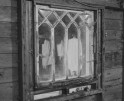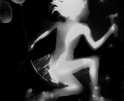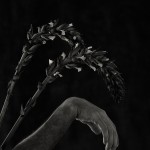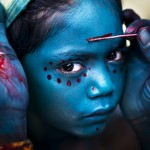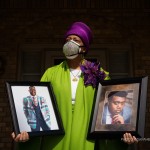Success Stories: Jessica Ingram
Congratulations to Jessica Ingram for being awarded Center’s Santa Fe Prize for Photography, jurored by Maggie Blancard of Twin Palms Publishing. Maggie states that Jessica’s series, A Civil Rights Memorial, “understands that people need a tool to become aware of the history around them, to see what would otherwise go unobserved. Jessica creates a portrait of civil rights atrocities that conveys more meaning.”
Born and raised in Tennessee, Jessica brings a southern perspective to much of her work. She received BFA in Photography and Political Science from New York University and her MFA from California College of the Arts and is now teaching at the California College of the Arts, San Francisco. Along with much recognition, this series also was awarded the 2009 PhotoNOLA Review Prize. Jessica’s work is widely published and exhibited, and she has received numerous awards, residencies, and public commissions.
A Civil Rights Memorial
Five years ago, I wandered downtown Montgomery in the sweltering heat, picked up a walking tour trail, and found myself facing a large, ornate fountain, situated on a brick pavilion. A Historical Marker said that I was standing on the former Court Square Slave Market, where slave traders sold men, women, and children to the highest bidder. It presented cold facts, detailing dollar values for slaves at the time and how none were given last names.
I was speechless. The fountain was erected at a time when this site was not considered for its history, the sign placed in a gesture of reconsideration. Moreover, the language printed on the sign was so void of sentiment – in no way testifying to the experience and meaning. I am from the American South, aware of the devastating history of slavery, but this site moved something in me that caught fire. I watched people pass by and wondered if they knew or thought of the history beneath their feet.
Site of Virgil Ware’s Murder, on the Docena-Sandusky Road, outside Birmingham, Alabama 
Curious about other histories and sites (marked and unmarked) I may be passing by in the American South, I began to research. I started with the founding of the Klan, as I vaguely knew it was founded not far from where I grew up. In Pulaski, Tennessee, I found the room where the six original members created the KKK. The original 1800s Historical Marker on the building has been unbolted, and rebolted so that only the back of the marker may be seen.
Over the next several years, I traveled repeatedly through Mississippi, Tennessee, Georgia, Alabama, and Louisiana, and documented sites where Civil Rights era atrocities, Klan activities, and slave trade occurred. In Money, Mississippi, I visited the remains of the store where 14-year-old Emmett Till allegedly whistled at a white woman, and the Tallahatchie River, where he was dumped after being tortured and disfigured. I traveled to Midnight, Mississippi, the birthplace of Rainey Poole, and saw the Sunflower River, where Poole was dumped after his murder in 1970. There are no markers in these places.
Crossing a Field, Near the Sunflower River
The Southern landscape is swallowing up these and other sites, as time is also burying these histories and leaving families without a sense of closure or justice. In this body of work, I am investigating how the affects of this history still reverberate in these communities and in the landscape. I hope to create this context in my photographs, and to remember these individuals and events through the images I am taking.
Tallahatchie River, Money, Mississippi
I have found each of these sites through research, and more importantly, have met and talked to family members and local people about the person who was lost, and the effects it had on both the family and the community. I have collected many of these conversations in audio oral histories. These histories are fresh for the people that lived them. In the majority of these cases, there was no justice, or justice came late, when cases were reopened in the 1990s and 2000s. Confessed murderers who were white were acquitted by all white juries. The justice system failed, and this history must also be considered and called to account, as the effects of this history still linger.
Medgar Evers’ Backyard, Jackson, Mississippi 
My larger body of work is about families and communities. This project is absolutely about that. It is a meditation and a recapturing. These images are renewed representations of these events- some of which have been excluded from the collective and mediated retelling of this period in American history.
Office Door, Pulaski, Tennessee
I N T E R V I E W
Congratulations on the Santa Fe Prize! It is very exciting and well deserved. Do you have plans for the award monies?
Thank you! I’m really excited to receive the award and honored to be included in such a talented group of artists. I plan to use the award to create a website for the project that can integrate the oral histories and historical documents from my research with the images I have made.
Moore’s Ford Bridge, Monroe, Georgia
A Civil Rights Memorial is such a thought-provoking series because what of lies beneath the surface of cursory historical facts and locations. It must be truly satisfying that you can use your photography to discuss history, politics, and human nature. Can you tell us about the project?
A Civil Rights Memorial is a photographic project about atrocities committed during the Civil Rights Movement in the American South and the related stories and legal cases. This project includes photographs of the sites where the atrocities were committed as well as sites related to slave trade and the formation and continuation of the Klan. The Southern landscape is swallowing up these and other sites, as time is also burying these histories, and leaving families without a sense of closure or justice. In this body of work, I am investigating how the affects of this history still reverberate in these communities and in the landscape. Historical ephemera including documents from the original FBI files, the Student Nonviolent Coordinating Committee (SNCC) and the NAACP are included. Accompanying the visual materials are oral histories from family members of victims, journalists and FBI agents working at the time, and journalists currently investigating cold cases.
As a Southern woman, did your investigations and conclusions change something inside of you? Did you feel closer to the work?
I started this project looking at these histories, landscapes, and memorials or lack thereof, with questions, and I end it with a greater personal connection to the impact of these events. I have spent several years working on this project and experienced and learned a great deal, and these experiences have shaped me and will forever be a part of me. I feel angry and ashamed at the injustice that was committed when heinous crimes were perpetrated and there was little to no justice, or justice came late, when cases started to be reopened in the 1990s. The justice system failed and must be called to account. I also have a deeper understanding about how memorials can function for a family or community, and the closure that can come through the process of memorializing these individuals.
What I have been most struck by is the time with the family members, and hearing them talk about the struggle and ultimately the transformation as they personally internalized and dealt with extraordinary events and tragedies.
My work explores the remarkable and complex ways that people respond to challenging and extraordinary circumstances. These stories are rooted to greater narratives that span generations and political histories and actions. In the midst of it all, though, these individuals talk of being transformed, replacing hate with forgiveness or love, and their personal journeys towards closure and moving forward. However, not all of them have found closure, and I’ve seen how devastating that can be.
Stone Mountain Confederate Memorial
I imagine that the families and local residents might have found some solace in your project, or were they hesitant to reopen wounds and doors?
I have received mixed responses from the families. All of them have a lot of questions for me, and it has been necessary to answer them and express why I am making this work. Most of those I’ve spoken with appreciate being asked to share their story, though find it painful to tell.
It is wrenching asking family members to open up when I can see the pain it is causing them. I am often apologizing, but they remind me that these are important stories to tell, and that telling is part of the healing process.
I understand you have some ideas about growing the project into a multi-media exhibition and website. Can you elaborate?
The research for this project is compelling. I would like for parts of this research, including FBI files, articles, historical imagery and ephemera to be included in some way. The oral histories are also integral, as well as the histories that inform the imagery I am making. A multi-media exhibition and website will allow these elements to come together in a meaningful, dynamic and informative way.
Bridge to Freedom, Selma, Alabama
I really enjoyed your project, Waiting for a Sign–you seem to have such a rich personal history and a sense of humor! Are you working on anything new?
Thank you! Waiting for a Sign is a very important project for me in my development as an artist, and I learned a lot about my family in the process. When dealing with family, I think a sense of humor is absolutely necessary.
Currently I am working on finishing the A Civil Rights Memorial book dummy and exhibition. I’m also working on the book dummy for Hilltop High, a project about a high school for pregnant teenagers in San Francisco. There is new work stewing–I’ll keep you posted!
Westbrook Cotton Gin, Liberty, MS
What advice can you give emerging photographers, especially on presentation, on networking, on consistently producing excellent work?
Most importantly, to keep going! I love being a photographer and feel extremely grateful for the experiences I have had and the people I have met while making work. There are moments when I am not sure I am on the right track and am tempted to give in to doubt, and I have to keep going, trust my instincts, and ask for feedback and support from my community.
Networking is important-I could definitely be better about it. There are so many great people in the art community, and it’s usually a pleasure to reach out to them. I learn a lot about professionalism from mentors and friends, and there are great resources out there about the business of being an artist. I try to be clear when talking about my work and keep people in the loop with what I am doing by showing up at events, sending updates, giving lectures, etc. It is primarily about nurturing relationships and following up.
Regarding presentation, it is always important to put your best out there, while also working in a way that is sustainable for you. You have to serve the work while maintaining balance (i.e. budget, etc). The importance of presentation cannot be overstated, and you have to be prepared to be your best advocate.
In my practice, I pursue my interests. When I am nervous or unsure, I remind myself that that is an OK thing, and not a reason to quit or turn away from something. Failure can also be a really good moment for growth and clarity, so I am often reminding myself to spend less energy worrying about failure and “what-if” and more energy making work and being open to possibilities found there.
Site of Frank Morris’ Shoe Shop, Ferriday, Louisiana
What would you say was the one thing that helped get your foot in the door, and took your exposure to the next level?
I am blessed with fabulous mentors. Their guidance, support, and recommendation have been incredibly important in taking my work to the next level.
I also have wonderful friends who are artists and generous about sharing opportunities and advice.
People like you, and organizations like Center, who support artists and get their work out there, strengthen individual photographers and the community as a whole. Exposure and financial support is key, but recognition and encouragement excites me and keeps me going, and has often come at some times when I really needed it.
Site of James Chaney, Andrew Goodman, and Michael Schwerner’s murder, Neshoba County, Mississippi, near Philadelphia
And finally, what would be your perfect day?
In terms of photographing, I love those days where I feel ON. That moment where I know I got the image as I take it, and I feel connected to whatever I am photographing. I love the energy and renewal that comes with a day like that.
Other perfect days involve a cup of coffee, a long sunny hike with my dog, and time in my studio to work on my work, where I can focus more and multi-task less, and periodically walk over to my bookshelf to be distracted by a terrific photo book.
Site of Mattie Green’s murder, Ringgold Georgia
Posts on Lenscratch may not be reproduced without the permission of the Lenscratch staff and the photographer.
Recommended
-
Interview with Kate Greene: Photographing What Is UnseenFebruary 20th, 2024
-
Semana Mexicana: Felipe “Chito” TenorioFebruary 5th, 2024
-
Amy Lovera in Conversation with Douglas BreaultJanuary 23rd, 2024
-
Michelle Bui: Affinités poreusesDecember 27th, 2023








